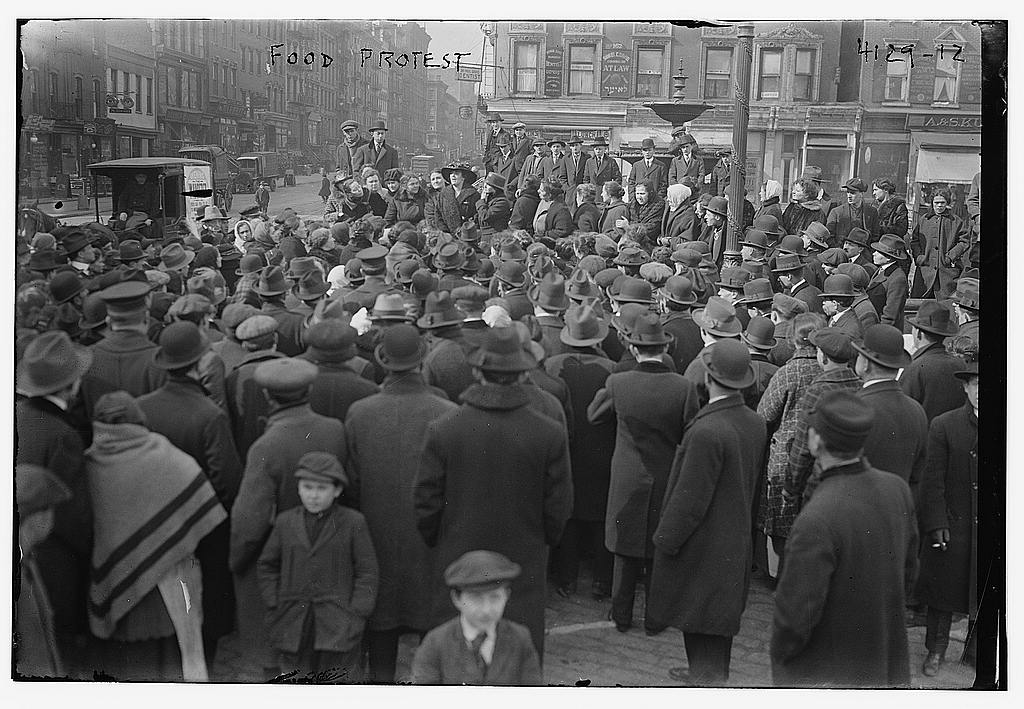New York City Food Riot Of 1917 on:
[Wikipedia]
[Google]
[Amazon]

 The New York City Food Riot of 1917 were a series of demonstrations and riots which began on February 19, 1917, after a mob composed mostly of women confronted store and pushcart owners over the raising of prices following the shortages of
The New York City Food Riot of 1917 were a series of demonstrations and riots which began on February 19, 1917, after a mob composed mostly of women confronted store and pushcart owners over the raising of prices following the shortages of
"The Food Riots Of 1917,"
The Gotham Center for New York City History (May 4, 2013). Archived a
On February 22, the women stormed the city's poultry markets, assaulting customers and destroying chickens.“Food Seizure by Commissioner, Governor’s Plan,” ''New York Times'' (February 23, 1917). On February 24, thousands of New Yorkers marched on

 The New York City Food Riot of 1917 were a series of demonstrations and riots which began on February 19, 1917, after a mob composed mostly of women confronted store and pushcart owners over the raising of prices following the shortages of
The New York City Food Riot of 1917 were a series of demonstrations and riots which began on February 19, 1917, after a mob composed mostly of women confronted store and pushcart owners over the raising of prices following the shortages of World War I
World War I (28 July 1914 11 November 1918), often abbreviated as WWI, was one of the deadliest global conflicts in history. Belligerents included much of Europe, the Russian Empire, the United States, and the Ottoman Empire, with fightin ...
.
History
Ida Harris, president of thesocialist
Socialism is a left-wing economic philosophy and movement encompassing a range of economic systems characterized by the dominance of social ownership of the means of production as opposed to private ownership. As a term, it describes the e ...
Mothers Vigilance Committee, and anarchist
Anarchism is a political philosophy and movement that is skeptical of all justifications for authority and seeks to abolish the institutions it claims maintain unnecessary coercion and hierarchy, typically including, though not neces ...
labour organizer Marie Ganz
Marie Ganz (1891–1968) was an anarchist and activist.
Biography
Marie was born in Galicia, Austria, in 1891. She started work at 8 years old and left school at 13 to work full-time as a delivery person, then in a sweatshop.
In 1914, she threat ...
, led the crowds through Manhattan's Lower East Side
The Lower East Side, sometimes abbreviated as LES, is a historic neighborhood in the southeastern part of Manhattan in New York City. It is located roughly between the Bowery and the East River from Canal to Houston streets.
Traditionally an im ...
. After another gathering on February 20, Ganz was arrested for "failing to comply with orders to stop stirring up the crowd."Ferrara, Eric"The Food Riots Of 1917,"
The Gotham Center for New York City History (May 4, 2013). Archived a
On February 22, the women stormed the city's poultry markets, assaulting customers and destroying chickens.“Food Seizure by Commissioner, Governor’s Plan,” ''New York Times'' (February 23, 1917). On February 24, thousands of New Yorkers marched on
Madison Square
Madison Square is a public square formed by the intersection of Fifth Avenue and Broadway at 23rd Street in the New York City borough of Manhattan. The square was named for Founding Father James Madison, fourth President of the United States. ...
, where "several high-profile speakers addressed the crowd."
The riots were effective in that "by the beginning of March, the city responded to the crisis by securing thousands of pounds of low-cost produce and wholesalers lowered prices." Although this succeeded in ending the riots, food prices
Food prices refer to the average price level for food across countries, regions and on a global scale. Food prices have an impact on producers and consumers of food.
Price levels depend on the food production process, including food marketing an ...
continued to "fluctuate sharply throughout the war."
See also
*List of incidents of civil unrest in New York City
This list is about incidents of civil unrest, rioting, violent labor disputes, or minor insurrections or revolts in New York City.
By date
Civil unrest in New York by date in ascending order, from earliest to latest.
* 1712 – New York Slave ...
References
Food Riot
Food riots may occur when there is a shortage and/or unequal distribution of food. Causes can be food price rises, harvest failures, incompetent food storage, transport problems, food speculation, hoarding, poisoning of food, or attacks by pes ...
1917 riots
Battles and conflicts without fatalities
Food riots
Riots and civil disorder in New York City
Political riots in the United States
{{NewYorkCity-stub